Article and all photos by Joe Mock, BaseballParks.com
All rights reserved
Many modern-day ballparks have been designed to rake in the maximum amount of revenue while overlooking the features that made the not-so-new parks fun and aesthetically pleasing. Things like overhangs, children’s areas and the ability to leisurely stroll around the park while taking in the action seem to take a backseat to money-makers like restaurants and luxury suites.
Make no mistake, Jacksonville’s new $34 million playground has the restaurant and the suites, but they didn’t forget that real ballparks should have a roof instead of a three-foot-wide afterthought sticking out from the top of the press box. Or that fun ballparks need to have places where kids can, well, be kids. And aesthetically pleasing facilities should permit you to watch the game while taking your time walking around the entire circumference of the grounds.
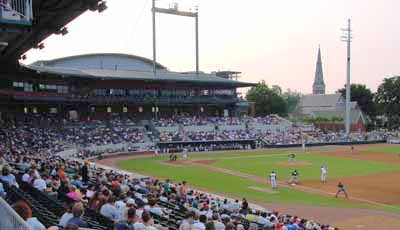 |
| What an interesting neighborhood! Yes, that’s a church steeple behind third base, and the top of a new basketball arena peeking over the stands. |
And “grounds” is a good word to describe the Jacksonville Sun’s new baseball stadium. Not only do the grounds of the facility provide more varied sights and sounds than any other park you can name, it provides the basis for the perfect name of the ballpark: The Baseball Grounds of Jacksonville. Join us as BASEBALLPARKS.COM “makes the rounds” at this special new park.
The Setting
Before we talk about the facility itself, let’s examine its setting. The ballpark is situated in Jacksonville’s already-existing sports complex. For years, that complex has included Alltel Stadium (prior to that, the old Gator Bowl stadium occupied that spot), a basketball-and-hockey arena and Wolfson Park, the Suns’ home for nearly five decades — not to mention a church, various businesses and some homes. Well, the contents of the complex are changing. Wolfson has been demolished now that it is no longer needed and a new practice field for the NFL Jaguars is going in its place. The arena has also been pulverized, and a shiny, much larger facility is nearing completion a block to the west. Needless to say, though, the best change to the complex is the beautiful new baseball park.
Some of the businesses remain, and, happily, Old St. Andrews Church. The church, in fact, shares the same block as the ballpark, giving a unique look to the baseball proceedings.
While the top of the new arena and the church and its steeple can be seen from the seats beyond first base and in right field, almost everyone in the main seating bowl has a view that is both stunning and varied. Alltel Stadium, home of the Jags as well as the 2005 Super Bowl, dominates the view beyond right field. Flanking the stadium, though, are two bridges that are very interesting to look at. One is the Hart Bridge and the other is the Matthews Bridge — both of which cross the St. Johns River.
And there are some fascinating views to look at when you’re not in your seats. There is quite a bit of water several blocks away behind first base, and the skyline of downtown Jacksonville is directly behind home plate. The best vantage point to view these sights is from the walkway that leads to the luxury boxes and press box. While there, check out the attractive, detailed brickwork all along the walkway.
The Exterior
And that brickwork is evident all along the streets behind first base and third base. Check it out as you enter the park behind home plate.
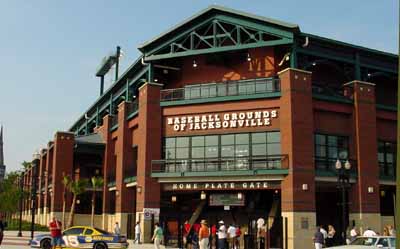 |
| The intricate brickwork and color scheme are stunning. |
Certainly, a great deal of effort has gone into the exterior of the park. In a way, though, it’s unfortunate that many fans won’t notice it, since you don’t really see the park from several blocks away as you are approaching it. The way the buildings are situated directly across the streets from the first-base and third-base sides means most visitors won’t be smitten with the lovely brickwork outside the way fans who are walking toward, say, The Ballpark In Arlington or Camden Yards are.
That’s not to say that the main entryway for The Baseball Grounds isn’t first rate — because it is. It is very attractive, but it is sort of odd that immediately upon entering the gate you have to go up quite a few steps before you can peer in at the playing field. In some respects, I guess, PNC Park and Pac Bell Park require that you do the same thing.
The Design
The design of this ballpark is wonderful, which the sports world has come to expect when HOK is the architect. And there are a number of trademark HOK elements here, such as the “open concourse” where you can see the field as you’re walking behind the main seating section. But this concourse goes much further than merely providing a good view of the action while you’re wandering to the bathroom. No, this concourse allows you to take a great journey all the way around the field. I refer to this as a 360-degree concourse, because at no point are you blocked when taking a stroll around the entire circumference of the field.
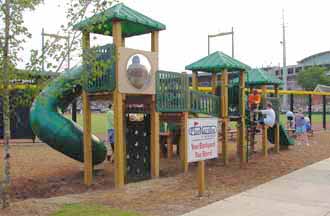 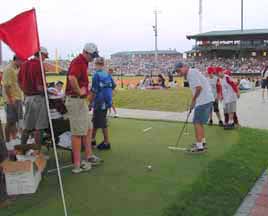 |
| While on your stroll around The Grounds, you’ll encounter a playground complete with see-through outfield fence behind it and, near the church building, a putting green. |
And I strongly urge you to take that stroll, because you’ll be able to see the action from a variety of wonderful vantage points, such as the plaza near the right-field foul pole, the landing of the stairs in center field, through the fences in left center, by the kids area in left field, by the putting green and the church in foul territory near the left-field foul pole, and from the party area (called the Palm Tree Pavilion) behind third base. This 360-degree concourse is one of the park’s best features.
The area for kids in left field is another. There is a super playground and a popular “moon bounce” there, and of course a grassy area where the kids can burn up some of their endless energy. Not far away is the putting green, which you probably wouldn’t notice unless you took that mandatory stroll!
One of the very best aspects of The Baseball Grounds is something that HOK often fails to incorporate into its ballparks: an overhang. I have long maintained that a baseball park that lacks a significant overhang looks unfinished to me. That’s one way in which older, more “classic” parks are more attractive than newer ones. Make no mistake about it, Jacksonville’s facility has a roof on it, and it’s a whopper — probably the largest I’ve seen at a minor-league park built in the last 20 years. Joe Block, the Suns’ excellent play-by-play announcer, told me that Peter Bragan, Jr., the team’s GM, was adamant with HOK that the overhang had to be large enough to be functional (i.e., to provide shade from the harsh Florida sun and protection from the frequent showers), not just the small ornamental things that are thrown on at most new stadiums.
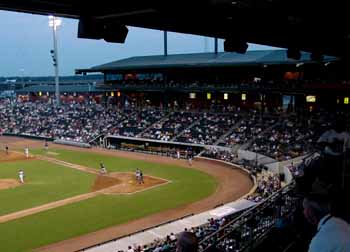 |
| The roof on Jacksonville’s new park is extra-large, just the way I like ’em. It does make the seating bowl a little dark, though. |
The Essentials
It’s not uncommon for new parks to provide more concession choices than their predecessors, and that’s true in Jacksonville. There is a very nice variety of foods, with my favorite being the Bubba Burger. Yum! You’ll also find pork BBQ, grilled chicken, pizza, peanuts (boiled and roasted) and for the more health-conscience, garden salads and fruit salads.
There’s also a good assortment of items in the nice-sized souvenir shop, which goes by the cute name of The Perfect Game. The prices for both the food items and souvenirs/apparel were not out of line for Class AA baseball. The parking, though, struck me as pretty high at $5.00 for lots near the stadium.
The ticket prices are a little higher than average in AA (although by no means do they approach the stratospheric level at Frisco’s new AA stadium), but not out of line for a new ballpark.
In Conclusion
Here’s the good, the bad and the ugly of The Baseball Grounds. First, the good. The best features are: the oversized overhang; the interesting and varied views; the concourse that is both “open” and “360 degrees;” the fun attractions, especially for kids; and the beautiful old church that sits within the park’s footprint.
It’s hard to find a bad element, but here’s a petty one: because the overhang is so large, it tends to make the main part of the seating bowl darker than at other parks. The light towers, that tend to point toward the field and not the stands anyway, can’t penetrate the large roof, and the illumination from the lights around the seating bowl aren’t sufficient to prevent the dark feel. However, if it comes down to a wrestling match over little or no overhang versus large overhang, I’ll take the darkness that comes with a big roof any day.
I also have a small gripe with the parking surrounding the park. Considering there’s acres and acres of asphalt surrounding the nearby football stadium, I’m not sure why getting to the correct lots for baseball was so confusing. Maybe I’m just easily confused.
And one thing that was ugly during my visit that will probably be all gone by the time you travel to Florida to see this lovely new stadium (and that could help with the parking!) was just beyond the right field wall. The day before my visit, the city had imploded the obsolete Veterans Memorial Coliseum that sat between the new ballpark and the football stadium. It was an unattractive pile of rubble while I was there, but I’m sure that the debris will be trucked off shortly — and no doubt chunks of it will show up on E-bay. Hopefully, that plot of ground will be turned into parking.
So to wrap it up, the Baseball Grounds of Jacksonville cost $34 million to build — and it looks like the lavish facility you would expect to get by spending that kind of money. By incorporating classic-ballpark elements like a huge overhang into a modern park with a wonderful walk-all-the-way-around concourse, Jacksonville has the “grounds” to claim the best minor-league ballpark in the Southeast.